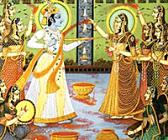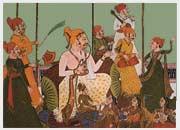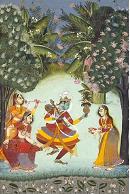Rural and traditional communities throughout India have evolved with their own regional customs and festivals, which are celebrated with Folk music unique to that community and region. It is almost impossible to identify all kinds of Folk music in India; however the most popular musical genre, sung during ‘Holi’, the festival of Colors is ‘Hori’. It is to note that the rural quality and the lilt to the word itself, makes a slightly phonetical slur on the alphabet 'Li' thus changing it to ‘Ri', by making it easier to enunciate Hori the musical genre, getting more easily accepted than Holi.

The tradition of playing colors on Holi draws its roots from a tradition of Radha and Krishna. It is said that young Krishna was jealous of Radha's fair complexion since he himself was very dark. He narrated his woe to mother Yashoda, who teasingly asked him to color Radha's face in which ever color he wanted. In a mischievous mood, Krishna applied color on Radha's face. Thus, the tradition of applying color on one's beloved is being religiously followed till date.
Interestingly Hori has both classical as well as semi-classical connections. These compositions are mainly based on the love pranks of ‘Radha-Krishna ' known for its connection with Vrindavan, the native place of Lord Krishna. When it is sung as a classical piece, it is a sequel to the Dhrupad form. Such horis are set to the tala Dhamaar, also classifying Dhammar as the musical genre itself, which has 14 beats. The excitement of hori is depicted skillfully in the Dhammar recitals by the use of tempo variations such as Dugun, tigun, Chaugun and aar, i.e double, triple, quadruple and also in the fraction of the same as one, one fourth, one and half and so on. The Dhrupad performers are experts in the art of calculating and measuring the time in music, along with the science of proper production of voice, intonation and modulation along with the proper development of the raga in its accuracy. Thus, horis sung as a concluding portion of a Dhrupad recital are classical in nature as well as treatment.
When Dhamaar is sung in lighter Taals and in a semi -classical repertoire incorporating the elements of thumri, the resulting composition is known as Hori. The traditionally sung Horis during the festival of Hori, describe the celebration of Krishna, his romance with Radha and the pranks he played with her and the cowgirls (gopis), depicting the Shringara Rasa, wherein underlying feeling of this fun-frolic was love and devotion, that can be still experienced even in the very atmosphere in the Krishna-nagari Vrindavan.
Most of the hori’s are sung in Raga kafi. Raga Kafi depicts love and passion and is used as a basis for many of the lighter compositions sung in the thumri style. Usually it is rendered in the late evening and uses all the seven notes in the ascending and descending order. Gandhar and Nishad are komal (flat) and all other notes are shuddha (full). ‘Holi khelat nand lal’ is a traditional Kafi Hori describing Krishna’s tales from folklore. Interestingly we find the poetic description of raga kafi as the poet describes her saying:
Kafi who inspires lust tenderly
sits on the lap of her playmate in the royal palace,
fond of parrots she is dressed in blue
and decked with jewels.
She is the image of sensuousness.
In the Lotus of my heart
I cherish her,
lovelier than Lakshmi
the goddess of Fortune.
Other than Raga kafi traditional Horis are also sung in many other ragas as Semi-classical compositions in ragas like Mishra kafi, Khamaj, Shahana kanhara, sarang, pilu and many mishra ragas. Significantly, horis are mostly set to a tala of 14 beats called Deepchandi and are also sung in teentaal (16 beats), Rupak (7beats), ektal (12beats) and jhaptaal (10beats). The famous Hori “Hori main kheloongi unsang dat ke, jo piya ayenge brij se palat ke”sung by Smt. Shobha Gurtu is an exquisite example of hori sung in thumri style in raga shahana kanhara set in a keherwa . At the conclusion of the hori, laggis are played on the tabla, which adds a bit of excitement after a spell of relaxed singing.
Though Horis are supposed to be about the love pranks of Krishna and Radha, there are some delightful exceptions too. One hori in raga Kafi is about Ram and Sita - Ram Siya Phag Machavat being the theme. Some of the traditional horis sung in thumri style such as ''Moke daar degi sari rang ki gagaria'' and ''Abb kaun gunan so manau hori aali, piya to manat nahi'' have their origin in the ancient past era of the Indian History and were very popular during the Mughal and contemporary periods.
It is interesting to note that Raja Mansingh Tomar of Gwalior (1486-1516 AD) was the driving force behind introducing and consolidating Dhrupad and composing three volumes of songs namely Vishnupadas (songs in praise of lord Vishnu), Dhrupads, and Hori and Dhamar songs associated with Holi. Mansingh's support gave a place of pride to these genres in the society, thereby relating music to the lives and language of the laymen.

The beautiful scene of Krishna's prank in which he played color with Radha and other gopis has been made alive in myriad forms in a number of paintings and murals. Besides, holi is celebrated at a time of the year when the fields are in full bloom and people are expecting a good harvest. This gives people a good reason to rejoice, make merry and submerge themselves in the spirit of Holi.

Celebration of the various traditions associated with Holi; reassure the people of the power of truth, as the moral of all these stories is the ultimate victory of good over evil. The story of Hiranyakashyap and Prahlad also points to the fact that extreme devotion to god pays as God always takes his true devotee in his shelter. Holi helps to bring the society together and strengthen the secular fabric of our country, as everybody like to be a part of such a colorful and joyous festival.
Also read
1. Travel to Vrindavan
2. Goverdhan Parikrama
3. To know all about Holi
Editor – Pictures taken from various sites through Google search. Courtesy and copyrights lie with those sites.